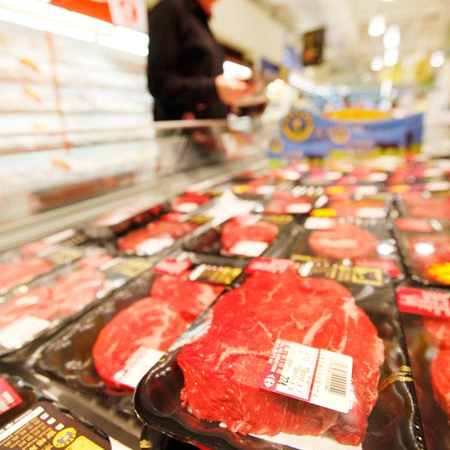 While the overall trend in expenditure in Meat & Livestock Australia’s global marketing budget next financial year will be down, modest reductions in funding in well-established, ‘mature’ markets will allow increases in emerging frontiers for beef exports where growth prospects are strongest.
While the overall trend in expenditure in Meat & Livestock Australia’s global marketing budget next financial year will be down, modest reductions in funding in well-established, ‘mature’ markets will allow increases in emerging frontiers for beef exports where growth prospects are strongest.
Export market destinations like China, the Middle East and the European Union will benefit from increases in marketing expenditure in 2013-14, while regions like Japan, Korea and domestic will see budgets trimmed.
This was the general thrust to emerge from MLA’s industry taskforce meetings held in Brisbane late last week, involving stakeholders from production, processing, retail and lotfeeding sectors. For the first time, in the case of the Indonesian task force region, live export stakeholders also took part.
MLA general manager, marketing, Michael Edmonds, said none of the budget adjustments for 2013-14 would be ‘drastic’, but simply reflected the ebbs and flows of global beef trade, and production patterns in Australia.
Overall, next year’s global beef marketing budget is expected to be about $2 million down on 2012-13, due to lower cattle transaction levy revenues.
“We’re currently in year three of a five-year marketing strategy that was laid down earlier,” Mr Edmonds said. “As part of that work, the global beef strategy had a portfolio review where we looked at where we saw the trade volumes coming from. We’re using that work to direct where our funds should flow,” he said.
Next financial year, there will be a continuation of MLA’s marketing funds moving away from the more mature markets to developing customer countries.
China is a case in point.
Coming out of nowhere, China was in fact Australia’s third largest export market by volume in February, exceeded only by the US and Japan, and easily larger than South Korea.
The medium -term growth in trade to China can be seen in financial year-to-date figures (last eight months, including February) which showed it has taken 46,200t of Australian beef, compared with just 5468t for the same period a year earlier. That’s a breathtaking 745pc lift in trade.
Read one of Beef Central’s earlier examinations of the reasons behind China’s sudden emergence as an export customer here.
 China will receive an increase in marketing funding next year, Mr Edmonds said.
China will receive an increase in marketing funding next year, Mr Edmonds said.
“A lot of the work we’re doing there at the moment is business development focussed, including activity like educational work with chefs. We also have our second-tier city strategy, where we are expanding the focus from the primary cities like Beijing to other extremely large, but lesser-known centres,” he said.
The Middle East, also a very strong export performer for Australia over the last 12 months, will also receive additional funds in the new fiscal year after June 30, as will the EU/Russia region, with the quota expansion opportunity for more high quality grainfed beef.
What that means, of course, is that the funds have to come from somewhere.
MLA’s overall beef marketing budget for next year is reduced, driven by a decline in levy revenue. Slaughter last year was below the five year average, and cattle movements were fewer than normal due to the widespread good seasonal conditions, slowing the rate of transactions, and levies generation.
“Certainly in the last month or so, kill numbers have obviously lifted substantially, so the levy flow may well turn around, but we have based our 2013-14 budget at the moment on a reduction in levies, worth a couple of million dollars across the board,” Mr Edmonds said.
Across the current financial year ending June 30, some short-term adjustments have already been made, and that will apply also in 2013-14.
Major markets where marketing expenditure will be reduced include Japan, Korea and the Australian domestic segment – all ‘mature’ markets for beef, where prospects for substantial growth are less.
“MLA will still have very significant programs in all three – we just have to be smarter about how we spend our money,” Mr Edmonds said.
“In the domestic market for example, we still have very significant funds invested, and have an important strategy to defend, as much as grow our share. While the domestic market represents about a third of all Australian beef sales by volume, it is more like half in terms of wholesale value, so we need to continue to have a strong presence in the marketplace.”
While there was a big jump in expenditure on domestic marketing program some years back due to adjustments to levies, in the past two years reductions in spending had been seen. But domestic is still the single largest area of expenditure for MLA marketing work.
Within the domestic program, MSA is a significant component.
“From an MSA perspective, we want to continue with the consumer education process about not only being able to identify the symbol, but have some understanding about what it means,” Mr Edmonds said.
Re-engaging MSA with the consumer was a program re-established last year, after a lengthy absence, at the behest of producers and retailers. That process, using the ‘What’s New?’ TV advertising channel and point-of-sale material, was repeated in February this year, and will continue.
The results from the MSA/consumer-engagement campaign last year was very successful, Mr Edmonds said, lifting awareness from single digits to around 50 percent of consumers.
“The question now is, how much further can that be improved?” he said.
“We’ve done some work with one of our research providers, and their view is that we should not be too ambitious – that we could spend a lot more money on that, without getting a great deal more awareness. The general view of awareness of new brands is that if you can get 50pc awareness, you are doing well.”
“Using the National Heart Foundation tick as an example, it really requires consumers’ experience with that brand for that awareness to grow further.”
While MLA’s plan is to continue to support the consumer awareness process for MSA, increasingly that is going to be about what the program means.
“Generally consumers now understand that MSA stands for quality meat, but not much beyond that. We have more work to do in that space, but it will take time,” Mr Edmonds said.
Overseas, Australia is reducing its marketing expenditure in Japan and Korea at a time when strong competitive pressures are evident with US re-entry, through both age limits on US beef, and tariff and currency advantages.
“The challenge in those markets for us is to spend our money wisely, and get maximum bang for our buck. In Japan, for example, apart from supporting Government with the FTA discussion process, we are investing heavily in initiatives that drive loyalty with the Japanese meat trade, as much as possible.”
“Trade missions and other activity are really about showing Japanese supply chain members the benefits of working with Australia, and reinforcing the message that we offer continuous supply.”
“There is no guarantee this year that there will be plenty of supply out of the US, given the impact of drought on US production levels, and that could impact on supply into both Japan and Korea.”
- Beef Central held discussions with a number of MLA regional managers from Japan, Korea, the EU and domestic regions during last week’s marketing Taskforce meetings in Brisbane. Reports will appear in coming days.
